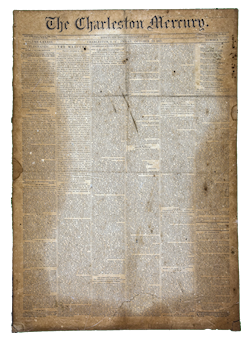January 16, 1861, The Charleston Mercury
New York, January 12, 1861.
M.G. ROBERTS, Esq;
SIR: After leaving the wharf on the 5th inst. at five o’clock, p.m., we proceeded down the bay, where we hove to and took on board four officers and two hundred soldiers, with their arms, ammunitions, &c. and then proceeded to sea, crossing the bar at nine o’clock p.m. Nothing unusual took place during the passage, which was a pleasant one for the season of the year.
We arrived off Charleston bar at 1:30 a.m. the 9th instant, but could find no guiding marks for the bar, as the lights were all out. We proceeded with caution, running very slow, and sounding until about 4 a.m. being then in four and a half fathoms of water, when we discovered a light through the haze, which at that time crossed the horizon. Concluding that the light was on Fort Sumter, after getting the bearings of it, we steered to the S. W. for the main ship channel, when we hove to await daylight, our lights having all been put out since 12 o’clock to avoid being seen.
As the day began to break, (we) discovered a steamer just in shore of us, which, as soon as she saw us, burned one blue light and two red lights, as signals, and shortly after steamed over the bar and into the ship channel. The soldiers were now all put below and no one allowed on the deck except our own crew. As soon as there was light enough to see, we crossed the bar and proceeded on up the channel (the outer bar buoy having been taken away). The steamer ahead of us sending off rockets and burning lights until after broad daylight continuing on her course up, near two miles ahead of us.
When we arrived about two miles from Fort Moultrie – Fort Sumter being about the same distance – a masked battery on Morris’s Island, where there was a red Palmetto flag flying, opened fire upon us – distance about five eighths of a mile. We had the American flag flying at our flag staff at the time, and, soon after the first shot, hoisted a large American ensign at the fore. We continued on under the fire of the battery for over ten minutes – several of the shots going clean over us.
One passed just clear of the pilot house. Another passed between the smoke stack and walking beams of the engine.
Another struck the ship just abaft the forerigging, and stove in the planking, and another came within an ace of carrying away the rudder.
At the same time, there was a movement of two steamers from near Fort Moultrie – one of them towing a schooner – (I presume an armed schooner) with the intention of cutting us off.
Our position now became rather critical; as we had to approach Fort Moultrie to within three fourths of a mile before we could keep away for Fort Sumter. A steamer approaching us with an armed schooner in tow, and the battery, on the island firing at us all the time – and having no cannon to defend ourselves from the attack of the vessels, we concluded that to avoid certain capture or destruction we would endeavor to get to sea. Consequently we wore round and steamed down the channel, the battery firing upon us until their shot fell short. As it was now strong ebb tide, and the water having fallen some three feet, we proceeded with caution, and crossed the bar safely at 8:50 a. m. and continued on our course for this port, were we arrived this morning after a boisterous passage.
A steamer from Charleston followed us for about three hours, watching our movements. In justice to the officers and crew of each department of the ship, I must add that their behavior while under the fire of the battery reflected great credit on them. Mr. Brewer, the New York pilot, was of very great assistance to me, in helping to pilot the ship over Charleston Bar, and up and down the channel.
Very respectfully,
Your obedient servant, J. McGOWAN, Captain.
